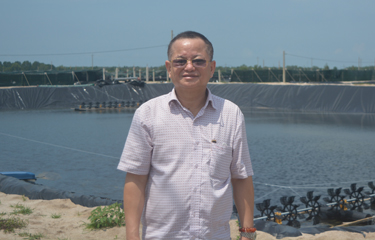Shipping costs, Ecuador’s US push hitting Minh Phu’s profitability

Rising freight rates and difficulties caused by the COVID-19 pandemic are making it harder for Minh Phu Seafood, Vietnam’s leading shrimp exporter, to meet its business targets this year.
The company’s profitability is being affected by fallout from the COVID-19 pandemic and global shipping issues. Minh Phu’s net profit between January and March plunged 51.7 percent year-on-year to VND 26.6 billion (USD 1.15 million, EUR 950,000), its lowest quarterly profit in four years.
Addressing questions from stakeholders, Minh Phu CEO Le Van Quang said on 17 June that the coronavirus outbreak in Vietnam during the country’s Lunar New Year festival in February affected the operation of the company’s processing plants. Many workers returning from their New Year break had to be quarantined for safety reasons, resulting in Minh Phu’s processing capacity dropping 30 percent in the first three months of 2021. In addition, the price of input materials for its business operations rose significantly in Q1 2021, while shrimp prices surged due to a market shortage.
However, it is a global shortage of containers and a subsequent increase in shipping costs that is worrying Quang the most.
Minh Phu has set a target of achieving VND 15.8 trillion (USD 685.7 million, EUR 577.8 million) in sales value and VND 1.1 trillion (USD 47.5 million, EUR 40 million) in net profit in 2021, which would be up 10 percent and 62 percent year-on-year, respectively. But with so much uncertainty complicating the company’s business, Quang predicted it will achieve just 80 percent of its VND 1.4 trillion (USD 60.9 million, EUR 51.3 million) net profit target, which was set in April.
Minh Phu typically relies on large shipping companies for the bulk of its transportation needs, but Quang said it is increasingly relying on smaller carriers for faster delivery of cargoes to its buyers, despite higher costs. Even with the change, Minh Phu has moved to further mitigate the impacts of the shipping crunch by signing fewer export contracts, affecting its business for the first half of 2021. Given the sky-high freight rates, Minh Phu has committed to fewer contracts – and only with selected partners for delivery within one month after signing – despite high demand from buyers, Quang said.
“Currently, shipping costs to many ports have risen by between two and four times year-on-year. And it remains unknown whether the costs will continue to hike and whether we will have sufficient containers to load goods. We are determined to fulfill the targets but the expected container shortage and rising freight rate situation is making it harder to achieve,” Quang said.
China’s Guangdong Province, which accounts for 24 percent and 19 percent of China’s exports and imports, respectively, is applying strict measures in an effort to contain a new outbreak of COVID-19 in the city. In addition, several containerships are stuck in U.S. ports dealing with active COVID-19 infections. That has exacerbated a shortage of available ships and shipping containers that has ramped up transportation costs in Asia and globally.
In May, Minh Phu signed contracts to sell 13,043 metric tons (MT) of shrimp with a total export value of USD 150.2 million (EUR 126.6 million). But, in comparison, between 1 to 16 June, the company inked deals covering just 3,500 MT of shrimp worth USD 45.4 million (EUR 38.3 million). As a result, the company has revised its outlook for its 1H 2021 profits to VND 300 billion (USD 13 million, EUR 11 million), Quang said.
However, Quang said Minh Phu has a plan to sign additional export contracts from the middle of July onward to take advantage of higher shrimp prices it expects on predicted production shortfalls in India and Indonesia. In fact, Quang said, shrimp prices have been on the rise since May and prices are expected to continue to rise through August, September and October before the year-end holiday season.
In another blow to Minh Phu’s business plan, the company is being forced to shift its emphasis away from the U.S. market after facing increasing competition from cheaper product from Ecuador. Facing a Chinese market that has become increasingly restricted, in part due to intensified customs inspections instituted in response to the Chinese government’s fear that COVID-19 could enter the country on the wrapping of frozen seafood, Ecuador has executed a quick pivot to the U.S. market. Ecuadorian shrimp exports to China decreased 39 percent in value and 32 percent in volume to USD 470 million (EUR 386 million) and 208 million pounds (94,346 MT) between January and April 2021, while the country’s shrimp exports to the U.S. between January and April more than doubled when compared to a year prior, reaching USD 300 million (EUR 246 million) and 120 million pounds (54,431 MT).
In response, Minh Phu is restructuring its market strategy, with the U.S. no longer being the top destination for its shrimp. The company will not try to compete with Ecuador on price in the U.S. and will instead send more shrimp to other markets such as Japan, other Asian countries, and the European Union, Quang said.
In the first five months of 2021, the U.S. accounted for 15.3 percent of Minh Phu’s shrimp export volume and 18 percent of its export value. As recently as two years ago, the U.S. accounted for more than 42 percent of Minh Phu’s total export value.
Minh Phu’s biggest markets between January and May included Japan, which purchased 22.8 percent of the company’s total exports by value; the E.U., which accounted for 15.1 percent of the company’s sales by value; Australia and New Zealand with 12.8 percent combined; Canada with 11.8 percent; South Korea with 7.13 percent; Russia with 5.75 percent; Hong Kong and Taiwan 3.14 percent; and China with 1.07 percent.
The numerous complications emerging from the continuing COVID-19 crisis has dented Minh Phu’s production expansion plans as well. Quang said the company’s supply of broodstock shipped to Vietnam from Hawaii has been intermittent, and bringing in equipment to be used in its farm construction has been difficult, resulting in delays to its farming expansion plans. In recent years, Minh Phu has put in a significant amount of investment in its two major farms – building a total of 400 ponds using its “2-3-4 technology” in the Loc An in Ba Ria-Vung Tau Province and 360 ponds in Kien Giang in Kien Giang Province.
Photo courtesy of Minh Phu Seafood






Share